|
|
|
|
|
|
|
|
|
The new Ministry of Transport 'Requirements' of 1925 prompted further change to the colours of lights in shunting signals. The practice of displaying a white light at certain shunting signals was discontinued, and either a red light or a yellow light was to be shown when a shunting signal was in the 'on' position. Certain shunting signals could legitimately be passed in the 'on' position, typically those that controlled movements from a group of sidings onto a running line but could be passed, without being cleared, if a shunting movement was to be made into a headshunt. To help drivers identify the signals concerned, the new requirements encouraged the use of a yellow light in the 'on' position and yellow colouring of the arm or face. A yellow indication in a shunting signal thus carries a quite different meaning from one in a main signal (see Section 2), functioning instead as a conditional stop indication. The Rule Book stated:
"Shunting signals showing a yellow arm or light may be passed, without being cleared, for movements in a direction for which the signal, when cleared, does not apply."
While the Great Western Railway opted to ignore the idea of yellow shunting signals, the other companies got on with converting some of their shunting signals to yellow. Where the earlier designs of shunting signals were involved, their red lenses were replaced with yellow ones and the red faces were simply re-painted yellow [4.52 - 4.54]. The 'off' indications remained as before.
 |
 |
 |
|
[4.52] Yellow Shunting Signal ('on').
Area: Various Usage: Medium Status: Historical |
[4.53] Yellow Shunting Signal ('on').
Area: Various Usage: Medium Status: Historical |
[4.54] Yellow Shunting Signal ('on').
Area: Southern Railway Usage: Medium Status: Historical |
|---|
Where semaphore signals were concerned, these were given a yellow lens and a yellow arm with a black stripe [4.55 & 4.56]. Miniature ground-mounted semaphore signals were similarly altered [4.57 & 4.58].
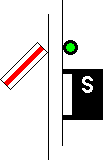 |
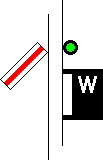 |
|
[4.55] Yellow Semaphore Shunting Signal ('on').
Area: All Areas Usage: Medium Status: Historical |
[4.56] Yellow Semaphore Shunting Signal ('off').
Area: All Areas Usage: Medium Status: Historical |
|---|---|
 |
 |
|
[4.57] Yellow Miniature Semaphore Shunting Signal ('on').
Area: Various Usage: Medium Status: Historical |
[4.58] Yellow Miniature Semaphore Shunting Signal ('off').
Area: Various Usage: Medium Status: Historical |
Where appropriate, banner type shunting signals were given yellow arms [4.59 & 4.60].
 |
 |
|
[4.59] Yellow Banner Shunting Signal ('on').
Area: Various Usage: Unknown Status: Historical |
[4.60] Yellow Banner Shunting Signal ('off').
Area: Various Usage: Unknown Status: Historical |
|---|
Many of the earliest resignalling schemes that provided colour light main signals had included shunting signals in the form of miniature colour lights, e.g. Charing Cross / Cannon Street (Southern Railway) in June 1926, and Cardiff East (Great Western Railway) in May 1933. These signals showed a red light for 'stop' [4.61], or a green light for 'proceed' [4.62]. Certain signals were equipped with a yellow lens [4.63] in place of the red. These applied as per other types of yellow shunting signals, i.e. they could be passed, without being operated to the green aspect, for a movement in a direction for which the signal when operated to the green aspect did not apply.
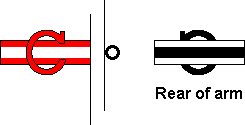 |
 |
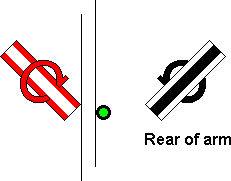 |
|
[4.61] Miniature Colour Light Shunting Signal ('on').
Area: Various Usage: High Status: Historical |
[4.62] Miniature Colour Light Shunting Signal ('off').
Area: Various Usage: High Status: Historical |
[4.63] Normally-Yellow Miniature Colour Light Shunting Signal ('on').
Area: Various Usage: Medium Status: Historical |
|---|
As upper quadrant semaphore signals came to be generally introduced (see Section 2), miniature semaphore shunting signals working in the upper quadrant became standard (except on the Great Western Railway) [4.64 - 4.67]. There was to be no upper quadrant version of the miniature ground-mounted semaphore signal, however.
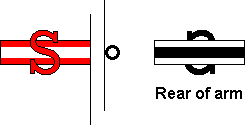 |
 |
|
[4.64] Upper Quadrant Semaphore Shunting Signal ('off').
Area: All Areas except GWR Usage: High Status: Current |
[4.65] Upper Quadrant Yellow Semaphore Shunting Signal ('off').
Area: All Areas except GWR Usage: Medium Status: Historical |
|---|---|
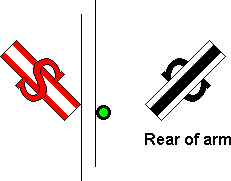 |
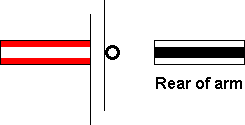 |
|
[4.66] Upper Quadrant Siding Signal ('off').
Area: Southern Railway Usage: Medium Status: Historical |
[4.67] Upper Quadrant Yellow Siding Signal ('off').
Area: Southern Railway Usage: Medium Status: Historical |
|
At least one of the ex-North Eastern Railway 'both ways' shunting signals (see [4.32 & 4.33]) (at Selby) survived long enough for it to be fitted with an upper quadrant arm [4.68]. |
|
In 1930, the Southern Railway introduced a standard form of shunting signal with a similar appearance to the GWR's disc signals (see [4.46 & 4.48]). Where a shunting signal could be passed, without being cleared, for a movement in a direction for which the signal when cleared did not apply, the Southern Railway continued to provide a semaphore type shunting signal with a miniature yellow arm, as opposed to a disc.
By 1932, the LNER was installing disc type shunting signals, but in contrast to those on the GWR and the Southern Railway, the LNER's disc signals worked to 45° in the upper quadrant when 'off' [4.69]. Where a signal in this form could be passed, without being cleared, for a movement in a direction for which the signal when cleared did not apply, the band on the face of the disc was coloured yellow [4.70 & 4.71], and a yellow lens was fitted instead of red.
|
The 1925 MoT 'Requirements' had stated that a special form of shunting signal for wrong-line movements was not considered necessary. Nevertheless, local circumstances sometimes made it desirable to inform the driver when a shunting movement was to be made in the wrong direction. Where this applied, the shunting signal authorising the movement could be accompanied by a 'wrong line indicator' comprising a white light with a black diagonal cross superimposed [4.72]. Several of these indicators were provided at Glasgow St. Enoch (LMS) in May 1933 and at Edinburgh Waverley West (LNER) in October 1936. |
|
Another form of shunting signal existed which possessed the same advantage as the miniature colour lights in having no moving parts, but which also satisfied the Three-Position Signalling Committee's recommendation that shunting signals should be of the 'position' type. Known as 'position light' signals, they had been supplied by Westinghouse for the 1928 resignalling scheme at Cape Town, South Africa. The LNER's resignalling between York and Northallerton in 1933 used identical position light signals. The 'stop' aspect was two white lights horizontally displayed [4.73], and the 'proceed' aspect was two white lights inclined upwards at 45° [4.74]. Thus, the position of the lights in each aspect corresponded to the angle of the coloured band or arm on a disc or banner type shunting signal. The same form of position light signal was provided in later resignalling schemes in the North Eastern Area of the LNER and to a lesser extent in the Scottish Area.
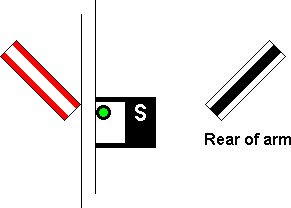 |
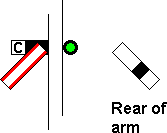 |
|
[4.73] Position Light Shunting Signal ('on').
Area: LNER Usage: High Status: Historical |
[4.74] Position Light Shunting Signal ('off').

Area: LNER (subsequently All Areas) Usage: High Status: Current |
|---|
Normal practice is to clear any facing shunting signals in the route beyond a main signal when that main signal is cleared, to prevent drivers from seeing a red light in the shunting signal. Since the original position light signals did not show a red light when 'on', it was considered acceptable not to clear them when preceded by a colour light signal showing a main 'proceed' aspect (i.e. single yellow, double yellow or green), drivers being permitted to disregard them in this circumstance. Position light signals associated with a main signal are not equipped to show an 'on' aspect and are only illuminated when a 'proceed' aspect is displayed (see [4.74]). An exception was made where the associated position light signal was ground mounted; originally, such signals could display an 'on' aspect.
|
In 1934, the LMS introduced a standard form of disc shunting signal that worked to 45° in the lower quadrant when 'off', the same as those on the GWR and the Southern Railway (see [4.48]). Where appropriate, the band on the face of the disc was coloured yellow [4.75], and a yellow lens was fitted instead of red. |
|
Discussions on the standardisation of aspects in colour light signalling areas began in 1933 at the instigation of the Ministry of Transport. In May 1934, the sub-committee of the Railway Clearing House agreed that:
"... the use of signals of the colour-light type as ground shunt signals in colour-light areas, is undesirable and that signals of the 'position' type should be adopted as standard. The actual type to be used cannot at present be standardised."
Although this precluded the future installation of miniature colour light shunting signals (see [4.61 - 4.63]), a standard form of shunting signal for use in colour light signalling areas was not proposed. Illuminated disc or banner signals were acceptable; however, they suffered the disadvantage of employing moving parts.
In view of the sub-committee's recommendation, the Southern Railway undertook trials early in 1935 to determine its future form of shunting signal to be used in colour light signalling territory. Two shunting signals that controlled movements from the Windsor Line Sidings at London Waterloo were involved in the trial. One signal was provided with floodlighting to illuminate the front of it during darkness [4.76 & 4.77], as an alternative to showing the usual red or green lights. The second signal was replaced by an experimental position light signal. For the 'stop' aspect, two white lights were displayed horizontally, the same as the position light signals on the LNER's North Eastern Area (see [4.73]). The 'proceed' aspect was different, however, comprising two white lights vertically displayed [4.78]. The two experimental signals were replaced by ordinary shunting signals in the summer of 1935.
 |
 |
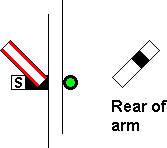 |
|
[4.76] Experimental Floodlit Shunting Signal ('on').
Area: London Waterloo Usage: Low Status: Historical |
[4.77] Experimental Floodlit Shunting Signal ('off').
Area: London Waterloo Usage: Low Status: Historical |
[4.78] Experimental Position Light Shunting Signal ('off').
Area: London Waterloo Usage: Low Status: Historical |
|---|
|
|
|